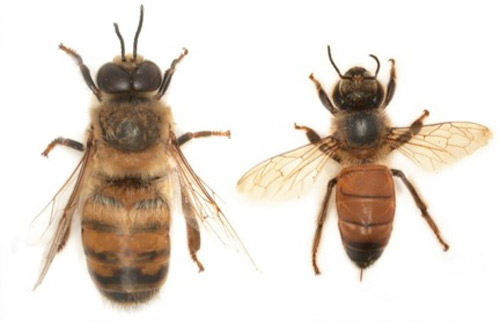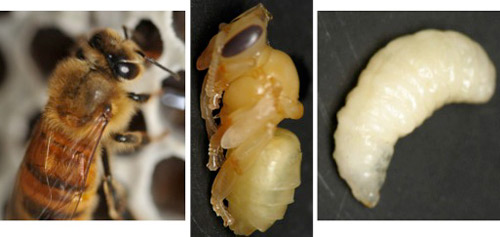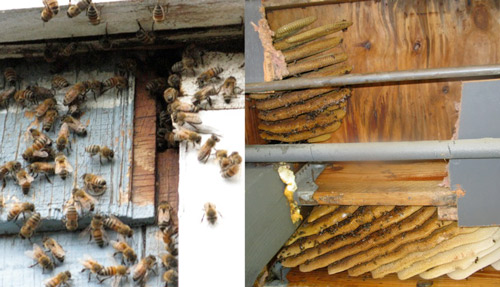European Honey Bees

General Information
The European honeybee, also referred to as the western honeybee, is a member of a swarm of bees in the Genus Apis that are extremely valuable for their honey-producing abilities and their role in pollinating plants, trees and crops. Because of this, European honeybees are one of the most popular domesticated honeybee species throughout the world.

Appearance
European honeybee adults vary in appearance based upon their caste and are either worker bee adults, drone adults or the colony's queen. The worker bees are about ½ inch long, yellow, and black in color and covered by numerous hairs on their bodies. Their major body parts are the head, thorax, abdomen, large dark colored eyes, two pairs of wings and three pairs of legs. When viewed from above, the junction between the thorax and abdomen is constricted and gives the adult the look of being "thread waisted." Another body part on honeybees is the "pollen sac" located on both rear legs. It is used to store pollen collected from plants the adult worker bee visits. Worker bees have a stinger they can use to help defend the colony. Workers are non-reproductive female bees. Drones are the colony's male caste. Their head, eyes and thorax are larger than the workers', and their abdomen is thick and blunt at the end, unlike the worker bees' pointed abdomen. Drones do not have a stinger. queens look much like larger versions of the workers but have a more rounded and longer abdomen. The queen also has a stinger that she rarely uses.
Behavior
European honeybees develop via the four-stage process of complete metamorphosis: egg, larvae (grub), pupae (cocoon), and adult. Honeybees also exhibit social organization and sharing of work and resources by the respective castes of bees. The only role of the drones is to mate with an unmated queen from another colony. The queen is the only egg layer in the colony and produces all the colony's eggs – up to about 1,500 eggs per day. Workers conduct all other work within the colony: defense, maintenance and nectar collection and honey production. Each worker bee provides various tasks based upon their age. The youngest workers care for the eggs, larvae, and pupae, while older workers build the wax combs, maintain honey storage, and defend the colony by stinging. Since the worker's stinger is barbed, it remains in their victim, resulting in the worker bee's death.

Reproduction
European honeybees expand their numbers by producing more colonies through swarming. That typically occurs in the spring and early summer when food sources are plentiful. The triggers for swarming are thought to be an abundance of nectar and pollen and the growth of colony size. The swarming process begins with a dozen or more daughter queens being produced by the colony's mother queen. When the daughter queens are in the late pupal stage, the mother queen and about 60-70 percent of the adult workers leave (abscond) the colony, swarm, and travel to a location where they will begin a new colony.
The new queen in the original colony will be one of the daughter queens that developed from one of the daughter queen eggs laid by the mother queen before swarming. A colony can only have one queen. Once daughter queens emerge as adults, they will fight until one queen is left alive. Should one daughter queen emerge from the pupal stage before the other daughter queens, she will hunt them out and kill them, thus becoming the sole surviving queen. After about a two-week period needed for the new queen to mature, she leaves the colony to mate with drones from other colonies and returns. Once successfully mated, the daughter queen begins laying eggs, thus insuring the continued survival of the original colony. In temperate climates where the season for pollen and nectar production is only a few months, bees usually swarm once per year. In other locations like the tropics, honeybees will commonly swarm more than once per year.

Signs of Infestation
Since honeybees are so valuable to our economic interests, extreme care should be taken to manage a problem created by honeybees. Without question, honeybee colonies can cause problems if a colony is in a wall void, a hollow tree on a homeowner's property or some other location where their presence creates a stinging hazard to pets and people.
Distribution
European honeybees are found in temperate regions throughout the world. Contrary to its name, the European honeybee is not a European native. Instead, these bees originated from the Middle East and Asia. They were named European honeybees because European colonists introduced them to North America.
European honey bees Removal
The only way to prevent the continuation of a honeybee infestation is to remove the nest entirely. Full removal may involve the demolition and rebuilding of walls, depending on the location of the nest. To keep repeat infestations from occurring, fill in voids with expanding insulation. Trapping the bees may become necessary but usually requires multiple months of surveillance. Contacting a pest control specialist typically offers the best course of action, as professionals possess the knowledge, training, and experience to manage large honeybee infestations and safely remove these important pollinators.
How to prevent honey bees from invading
Avoiding bees can prevent problems from occurring in the first place. Unlike wasps, most bee species, are not naturally aggressive and become hostile only when provoked or nesting areas become disturbed. For specific species of bees, different preventative tips may also help. With leaf cutter bees, protecting plants with cheesecloth or some other sort of barrier may shield the vegetation from damage. Along the same lines, painting or staining and weather-treating wood structures often dissuades carpenter bees from attempting to nest, as the insects tend to only attack weathered and untreated wood. While bees typically display nonaggressive behaviour, large infestations may still lead to attacks and stings on humans and pets alike. For the proper removal and prevention of bee infestations, contacting a trained pest control specialist is typically the most serviceable solution.
Commonly Asked Questions
The European honey bee nests in hollow trees and similar types of cavities. At times, these insects construct nests near human habitations, such as alcoves, under beams, and in wall voids.
Because these insects use stinging as a defence mechanism, humans and domesticated animals alike could be at risk when nests are established close to manmade structures. Generally harmless in most cases, the venom from a European honey bee sting may prove fatal to people with serious bee allergies. Removal of the nest remains imperative and may require the services of a pest control professional.
